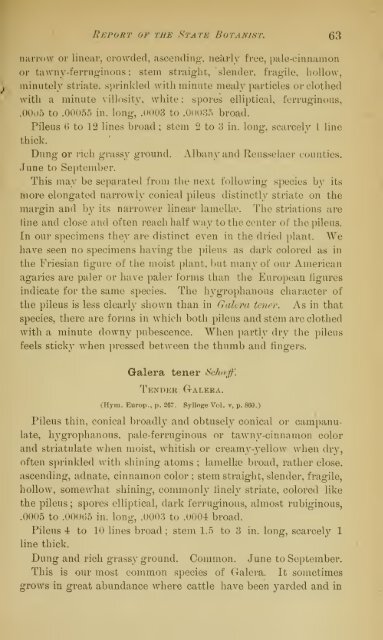Annual Report of the State Botanist 1892 - MykoWeb
Annual Report of the State Botanist 1892 - MykoWeb
Annual Report of the State Botanist 1892 - MykoWeb
You also want an ePaper? Increase the reach of your titles
YUMPU automatically turns print PDFs into web optimized ePapers that Google loves.
<strong>Report</strong> <strong>of</strong> <strong>the</strong> <strong>State</strong> <strong>Botanist</strong>. 63<br />
narrow or linear, crowded, ascending, nekrly free, pale-cinnamon<br />
or tawny-ferruginous; stem straight, slender, fragile, hollow,<br />
ininntely striate, sprinkled with minute mealy particles or clo<strong>the</strong>d<br />
with a minute villosity, white ; spores elliptical, ferruginous,<br />
.0005 to .00055 in. long, .0003 to .00035 broad.<br />
Pileus 6 to 12 lines broad ; stem 2 to 3 in. long, scarcely 1 line<br />
thick.<br />
Dung or i-ich grassy ground. Albany and Rensselaer counties.<br />
June to September.<br />
This may be separated from <strong>the</strong> next following species by its<br />
more elongated narrowly conical pileus distinctly striate on <strong>the</strong><br />
niargin and by its narrower linear lamella\ The striations are<br />
fine and close and <strong>of</strong>ten reach half way to <strong>the</strong> center <strong>of</strong> <strong>the</strong> pileus.<br />
In our specimens <strong>the</strong>y are distinct even in <strong>the</strong> dried plant. We<br />
have seen no specimens having <strong>the</strong> pileus as dark colored as in<br />
<strong>the</strong> Friesian figure <strong>of</strong> <strong>the</strong> moist plant, but many <strong>of</strong> our American<br />
agarics are paler or have paler forms than tlie European figures<br />
indicate for <strong>the</strong> same species. The hygi'ophanous character <strong>of</strong><br />
<strong>the</strong> pileus is less clearly shown than in GaUra tener. As in that<br />
species, <strong>the</strong>re are forms in which both pileus and stem are clo<strong>the</strong>d<br />
with a minute downy pubescence. When partly dry <strong>the</strong> pileus<br />
feels sticky when i^rcssed between <strong>the</strong> thumb and fingers.<br />
Galera tener Schaff.<br />
Tender Galeea.<br />
(Hym. Europ., p. 267. Sylloge Vol. v, p. 860.)<br />
Pileus thin, conical broadly and obtusely conical or campanu-<br />
late, hygrophanous, pale-ferruginous or tawny-cinnamon color<br />
and striatulate when moist, whitish or creamy-yellow when dry,<br />
<strong>of</strong>ten sprinkled with shining atoms ;<br />
ascending, adnate, cinnamon color ;<br />
lamelhe broad, ra<strong>the</strong>r close,<br />
stem straight, slender, fragile,<br />
hollow, somewhat shining, commonly finely striate, colored like<br />
<strong>the</strong> pileus ;<br />
spores elliptical, dark ferruginous, almost rubiginous,<br />
.0005 to .00005 in. long, .0003 to .0004 broad.<br />
Pileus 4 to 10 lines broad ; stem 1.5 to 3 in. long, scarcely 1<br />
line thick.<br />
Dung and rich grassy ground. Common. June to September.<br />
This is our most common species <strong>of</strong> Galera. It sometimes<br />
grows in great abundance where cattle have been yarded and in
















